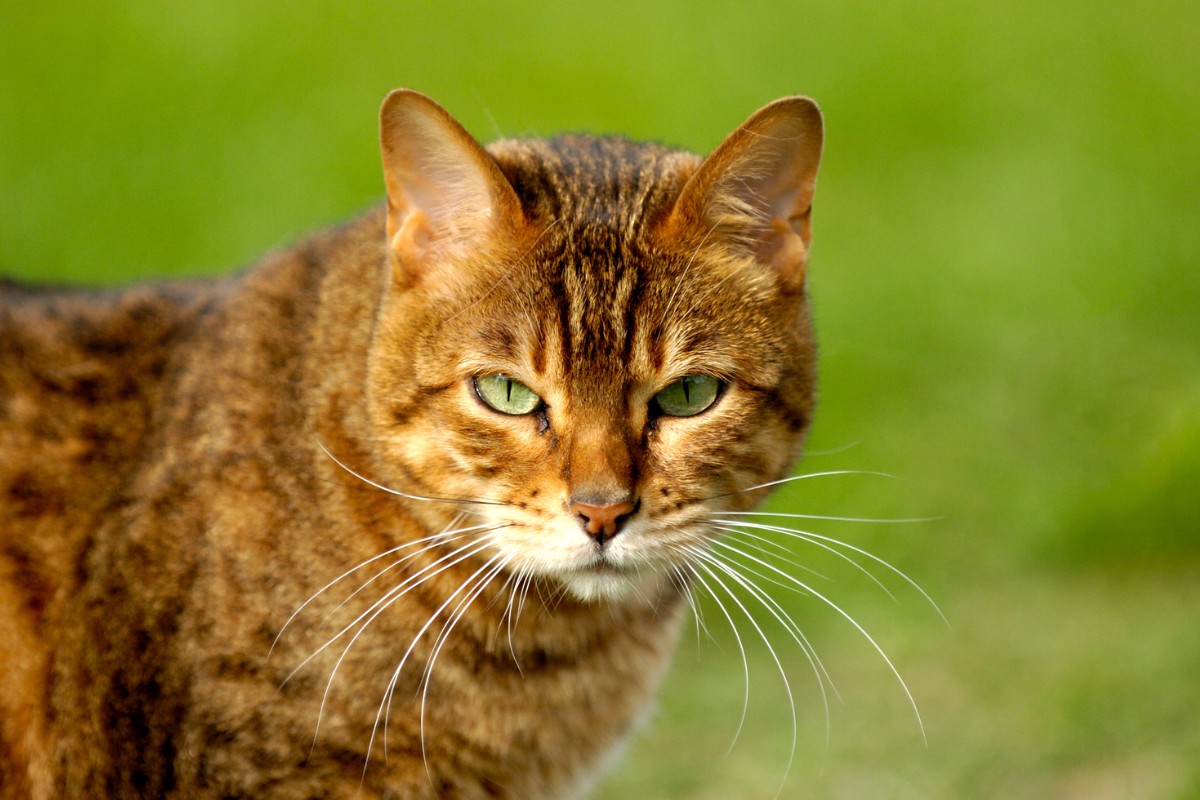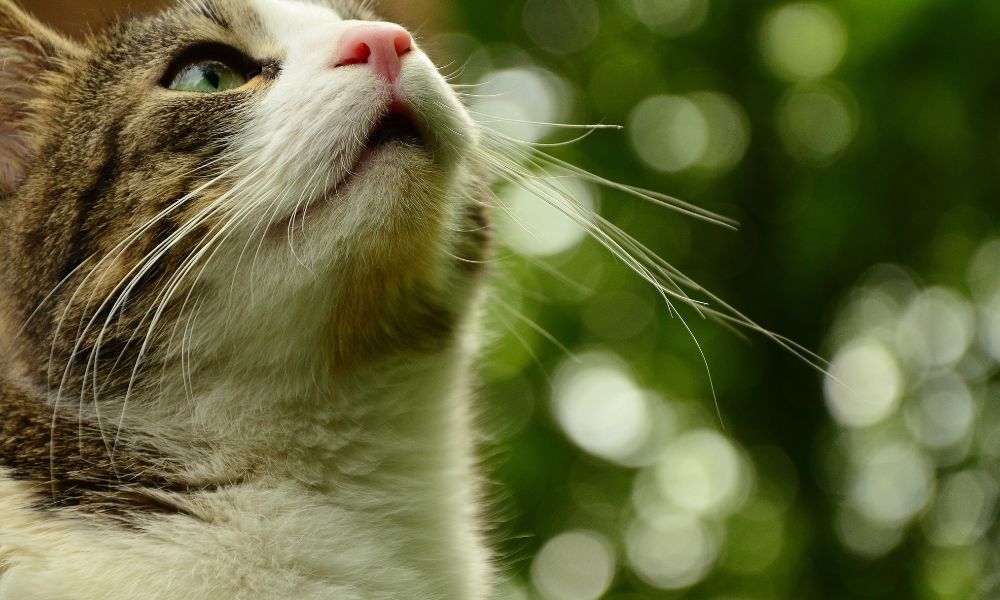 9 Nov
9 NovCan Cat Whiskers Be Trimmed?
Can cat whiskers be trimmed? At first glance, you might think it’s a simple issue of grooming, but cat whiskers are more than just facial hair. These fine threads play a vital role in your feline friend’s well-being.
Now, I’ve been around cats long enough to know that their whiskers serve as high-precision sensors that guide them through the dark, gauge tight spots, and add to their acute hunting abilities. Given the importance of these sensory tools, the idea of trimming them warrants a closer look. So is it okay to trim cats’ whiskers?
No, cat whiskers should not be trimmed. Whiskers are essential sensory tools for cats, crucial for their spatial awareness and ability to navigate their environment. Trimming them can cause confusion, and stress, and impair their ability to function normally.
So, is it ever safe or necessary to trim a cat’s whiskers? In this post, we’ll explore the function of whiskers, the repercussions of cutting them, and how to properly care for your kitty’s curious tactile hairs.
Whether you’re a seasoned cat owner or new to the world of whiskered companions, you’ll find valuable insights into one of the most distinctive features of our feline pals. Let’s get right to the point—your cat’s whiskers are a no-cut zone, and we’ll tell you why.

The Consequences of Trimming Cat Whiskers
Trimming a cat’s whiskers might seem like a harmless grooming practice, but it can lead to a range of unintended and distressing consequences for your feline friend. Here’s what you need to know about the potential physical and psychological effects of whisker trimming, backed by insights from veterinary professionals and feline behaviorists.
Physical Effects of Whisker Trimming
Firstly, whiskers are deeply embedded in your cat’s skin and are rich with nerves at the base. While trimming the whiskers doesn’t cause pain, as the whiskers themselves don’t have nerve endings, it profoundly affects how your cat perceives their environment.
Cats rely on their whiskers to gauge space and distance; when whiskers are trimmed, cats may become disoriented. They can struggle with everyday activities such as jumping onto surfaces, navigating through narrow spaces, or even eating and drinking.
Trimmed whiskers can also impact a cat’s ability to balance. This is because whiskers help to provide information about the position of their body and head, helping them maintain their famed agility and poise. Without the full function of their whiskers, cats can appear clumsier and more prone to accidents.
Psychological Effects of Whisker Trimming
Psychologically, the effects of whisker trimming can be quite severe. Cats may exhibit increased levels of stress and anxiety when their whiskers are no longer available to provide the necessary feedback about their surroundings.
These sensory inputs are a core part of a cat’s ability to interact confidently with the world around them. Deprived of this ability, cats can become withdrawn or exhibit signs of fearfulness and disorientation.
Veterinary professionals have observed that cats with trimmed whiskers may demonstrate a reduced interest in play or exploration, behaviors that are critical for a cat’s mental and emotional health. This change can lead to a decrease in stimulation and an increase in stress-related behaviors, such as hiding or avoidance.
Veterinary advice is clear: whisker trimming can interrupt your cat’s sensory perception and lead to a bewildering experience. Their spatial awareness is so tied to their whiskers that altering them can disrupt their fundamental ability to engage with the world.
How Cats Use Their Whiskers in Daily Life
Cats’ whiskers are an extraordinary evolutionary adaptation that plays a crucial role in their daily activities. These tactile hairs, or vibrissae, are more than just facial features; they are integral tools that enhance a cat’s interaction with the world. Let’s look at the various functions whiskers serve in a cat’s life.
1. Measuring Gaps and Spaces
One of the most fascinating uses of cat whiskers is spatial assessment. Whiskers are roughly as wide as a cat’s body — this isn’t a coincidence. As a cat approaches a narrow gap or an opening, it uses its whiskers to gauge whether it can fit through. If the whiskers brush against the sides of the opening, the cat can determine that the space is too small, thus avoiding getting stuck. This is crucial when they explore tight spaces or navigate through the dark.
2. Enhancing Hunting Abilities
During hunting or play, whiskers act as precision instruments. When a cat stalks its prey, it keeps its whiskers forward. This positioning helps the cat detect even the slightest change in air currents, indicating the movement of prey nearby. This sensory input allows the cat to pounce with remarkable accuracy, even in complete darkness.
3. Detecting Environmental Changes
Whiskers are highly sensitive to vibrations in the air currents around them, which helps cats sense approaching dangers or changes in their surroundings. They can detect the slightest breeze or movement, providing critical information about the size, shape, and speed of objects nearby, often before the cat can see or hear them.
4. Whiskers as Mood Indicators
Moreover, whiskers can reflect a cat’s mood. When relaxed, a cat’s whiskers will remain still and stick out sideways. In contrast, when a cat is on high alert or feels threatened, its whiskers will point forward. This subtle language of whiskers is often an overlooked aspect of how cats communicate their comfort or discomfort with their surroundings.
Proper Whisker Care
While whiskers are low-maintenance and don’t typically require special care, there are ways you can ensure they remain in good condition to support your cat’s well-being. Here are some tips on how to properly care for your cat’s whiskers and what to do if you notice any issues.
Tips for Whisker Care
- Avoid Physical Alteration: The first and most important aspect of whisker care is to never trim, cut, or pull on them. Whiskers are a critical part of your cat’s sensory apparatus, and altering them can lead to disorientation and stress.
- Be Mindful of Bowls: Use wide, shallow food and water bowls to prevent whisker fatigue. Whiskers are sensitive, and when forced into a narrow space, such as a deep bowl, they can get bent or pushed, causing discomfort. This is why some cats may refuse to eat or drink from deep bowls, a condition sometimes referred to as “whisker stress”.
- Provide a Safe Environment: Ensure your cat’s living environment is safe from sharp objects or tight spaces where whiskers might get bent or broken. A cat’s whiskers are generally as wide as its body, so it’s important to keep their pathways clear of obstructions.
- Gentle Handling: When petting your cat, be gentle around the whisker area. Rough petting can cause the sensitive whiskers to bend, leading to discomfort.

Dealing with Damaged or Falling Out Whiskers
- Understand Natural Shedding: Just like hair, it is natural for a cat to shed a few whiskers occasionally. However, if you notice excessive loss or damage, it might be a sign of an underlying issue.
- Check for Health Issues: Excessive breakage or loss can sometimes be associated with nutritional deficiencies or health problems such as dermatitis, hormonal imbalances, or stress. If you notice abnormal whisker loss, it’s essential to consult a veterinarian.
- Observe Behavior Changes: If you notice your cat’s whiskers are damaged and they’re showing signs of distress, such as disorientation or lack of appetite, seek veterinary advice.
- Minimize Stress: A stressed cat may over-groom and damage its whiskers. Providing a peaceful and stable environment, along with plenty of play and stimulation, can help reduce stress levels.
- Nutritional Support: A well-balanced diet contributes to a cat’s overall health, including the condition of its whiskers. Ensure your cat is getting all the necessary nutrients to support healthy skin and hair.
Alternatives to Whisker Trimming
If you’re concerned about the length of your cat’s whiskers or if you believe they’re causing issues, rest assured that there are safe alternatives to whisker trimming. Here are some solutions and pieces of professional grooming advice, especially for longhaired breeds.
Grooming for Longhaired Breeds
Longhaired cats might have whiskers that blend into their fur, making them seem longer or prompting concerns about maintenance. Here’s how to handle grooming without compromising the whiskers:
- Regular Combing: Keep your longhaired cat’s coat tangle-free with regular combing. This will prevent the whiskers from getting caught in mats and reduce any potential discomfort.
- Facial Trimming: If necessary, a professional groomer can trim the fur around the whiskers carefully, without touching the whiskers themselves. This can tidy up the cat’s face and reduce any perceived ‘messiness’.
- Whisker Checks: During grooming sessions, check the whiskers for any signs of damage or dirt and gently clean around the whisker pads with a soft, damp cloth if needed.
Managing Whisker-Related Issues
- Behavioral Concerns: If your cat seems to be struggling with whisker-related issues, such as whisker fatigue from deep bowls, simply switch to shallow dishes. This can alleviate stress and make meal times comfortable again.
- Environmental Adjustments: Make environmental adjustments if you think your cat’s whiskers are affecting its navigation. Remove or reposition furniture and keep pathways clear to give your cat plenty of space.
- Veterinary Consultation: If you notice that your cat appears bothered by its whiskers—perhaps pawing at them or showing signs of discomfort—consult your vet to rule out any medical issues.
- Stress Reduction: Ensure your cat has a stress-free environment as stress can sometimes cause them to mess with their whiskers. Provide hiding spaces, playtime, and a stable routine.
When to Be Concerned About Your Cat’s Whiskers
While a cat’s whiskers are generally self-maintaining, there are certain situations that may warrant concern. Being aware of the signs of whisker stress and understanding the natural cycle of whisker shedding and growth can help you ensure your feline friend remains comfortable and healthy.
Signs of Whisker Stress
Whisker stress, also known as whisker fatigue, can occur when a cat’s sensitive whiskers are repeatedly stimulated, such as by contact with the sides of a narrow feeding bowl. Signs of whisker stress include:
- Avoidance of Food or Water Bowls: If your cat is hesitant to eat or drink from its bowls, especially if they are deep or narrow, they may be experiencing whisker fatigue.
- Pawing at Food and Water: Some cats will attempt to remove food from their bowls and eat it off the floor to avoid touching their whiskers to the sides of the bowl.
- Changes in Behavior: Look for changes such as irritability, a decrease in appetite, or a reluctance to explore as usual, which may be related to discomfort from their whiskers.
Understanding Whisker Shedding
Like other hair on a cat’s body, whiskers also go through a natural shedding cycle. A few points to understand include:
- Natural Shedding: It’s normal for a cat to shed a few whiskers as part of the natural growth cycle. You might occasionally find a whisker around your home.
- Regrowth: Lost whiskers will regrow to their appropriate length without any intervention needed. It’s a process that is entirely painless for the cat.
- No Pain with Shedding: Since whiskers fall out naturally, they don’t cause a cat discomfort when they shed, unlike what might occur if they were forcefully pulled or trimmed.
When to Be Concerned
While natural shedding is normal, there are times when you might need to be concerned about your cat’s whiskers:
- Excessive Loss: If you notice your cat losing more whiskers than usual or if there are bald patches without whiskers, it’s time to consult a veterinarian.
- Visible Damage: Whiskers that are split, broken, or appear damaged can indicate a problem. While a single broken whisker isn’t usually a cause for alarm, multiple damaged whiskers need professional attention.
- Behavioral Changes: If your cat seems disoriented, confused, or has trouble navigating familiar spaces, this may be a sign of an issue with their whiskers or overall health.
- Associated Symptoms: If whisker issues are accompanied by other symptoms, such as skin issues, changes in eating habits, or lethargy, a vet visit is warranted.
In summary, while it’s important not to overreact to natural shedding or minor whisker breaks, staying observant of your cat’s behavior and whisker condition can help you catch and address any potential issues early on. A proactive approach and regular check-ups with your veterinarian will ensure your cat’s whiskers, and their overall health, remain in tip-top shape.




